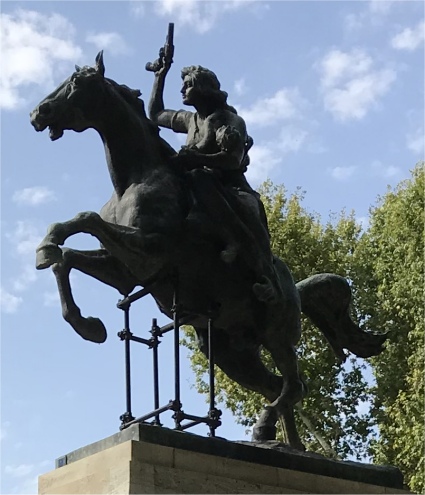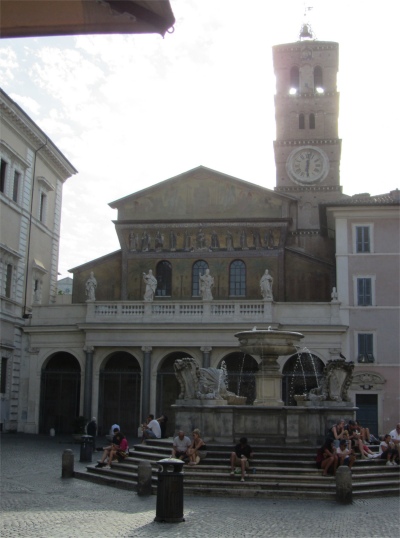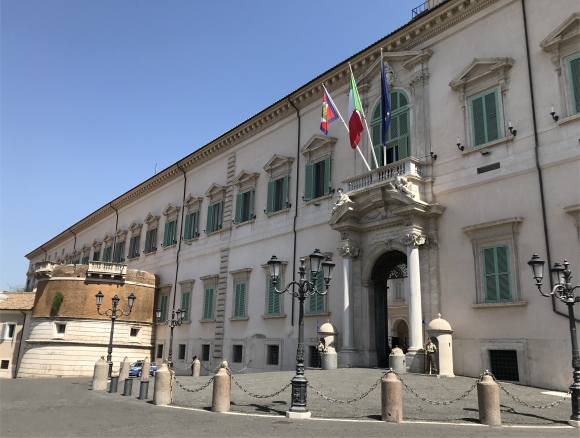 Palazzo Del Quirinale |
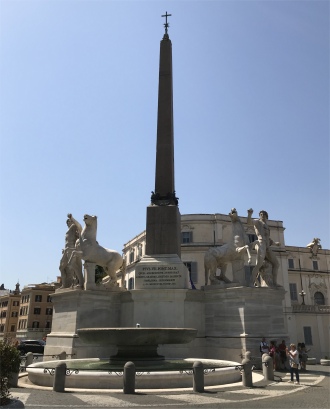 Piazza Del Quirinale |
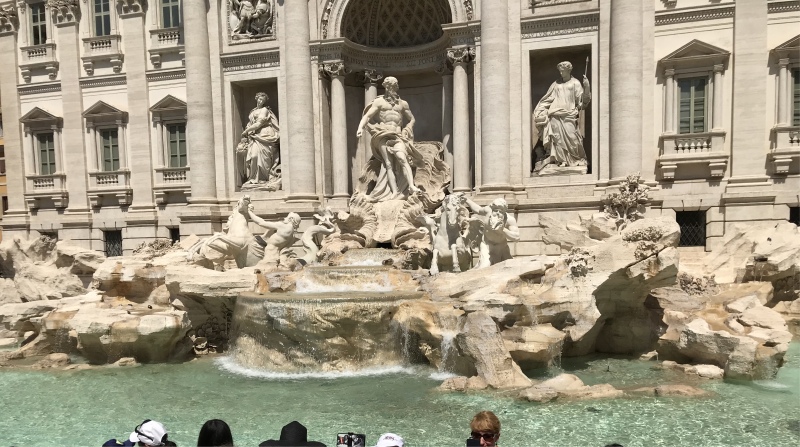 Trevi Fountain |
We dropped down from the hill, weaving a way through a maze of streets throbbing with gaudy souvenir shops, takeaway pizzerias, and gelatorini: I could almost feel my arteries clogging up. The hum of a thousand voices guided us. Then we stepped out into the tiny Piazza Trevi, located at what was once the meeting point of three ways (Tre Vie), and dominated by the beautiful oasis of the Trevi Fountain.
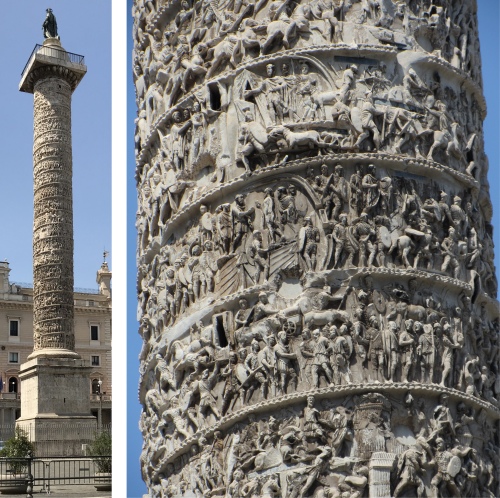 The Column of Marcus Aurelius |
The origins of the fountain go back to the year 19 BC, in which period the fountain formed the end of the 14 mile long Aqua Virgo aqueduct. The first fountain was built during the Renaissance, under the direction of Pope Nicholas V. The final appearance of the Trevi Fountain dates from 1762, when after many years of work at the hand of Nicola Salvi, it was finalized by Giuseppe Pannini. The central feature of the monument is a chariot in the shape of a shell, drawn by seahorses with conch-blowing Tritons as their guide. Before the enormous central niche stands Neptune. To the side are the statues of Abundance and Salubrity. All around, natural and artificial forms merge together in a representation of rocks and petrified vegetation that run along the foundation of the palace and around the borders of the pool, which represents the sea.
This jewel was hemmed in by a sea of zaparazzi, a forest of selfie stalks, and gaggles of Japanese girls stood in every conceivable pose for their friends before swapping places. The ubiquitous Carabiniere and military pair kept a cautious eye on the proceedings. We enjoyed an ice-cream, and tossed coins into the fountain. There is a myth associated with the Trevi Fountain, originating in 1954 with the movie "Three Coins in the Fountain." It goes like this:
If you throw one coin: you will return to Rome.
If you throw two coins: you will fall in love with an attractive Italian.
If you throw three coins: you will marry the person that you met.
 Obelisk of Montecitorio |
A pigeon landed on the creamy rocks to sip the waters, oblivious to the throng of humanity close by. Then my eyes landed on the carved stone bench by the fountain where I sat 48 years earlier with a guitar I had just acquired. I remembered it as though it were yesterday. My, how time has flown by.
We agreed to escape the din, and soon found ourselves passing through the Piazza Colonna dominated by the Column of Marcus Aurelius. It is thought to have been erected by Commodus in memory of his father and mother sometime around 180AD. The column was inspired by its more famous predecessor Trajan's Column which was set up, also in Rome, in 113 AD. The column carries representations carved in high relief of the emperor's successful military campaigns against the Quadi across the Danube between 172 and 175AD.
The column presently stands 39 metres tall but a further 7 metres of the base structure remains underground, the lowest portion never having been excavated. The Doric column is more or less straight (only 14 cm wider at the base) and is covered in relief carvings in 21 spirals - each being some 130 cm in height- which depict the campaigns of Marcus Aurelius in the territories north of the Danube, first against the Marcomanni (172-3AD) and then against the Sarmatians (174-5AD). The narratives of the two campaigns are divided on the column by a figure of Victory who writes on a shield and the first begins from the base with troops crossing the Danube river. The vast majority of episodes are those from the battlefield but there are some interesting background scenes such as the emperor addressing his troops and even glimpses of the logistics and engineering feats performed in Roman warfare such as one depiction of troops crossing a pontoon bridge. The reliefs are typical of the style that would come to dominate Late Antiquity sculpture. There is an emphasis on frontal views with perspective achieved simply by having smaller figures in rows above the foreground and with figures rendered not quite in proportion, heads being too large and bodies being either too short or elongated, and with facial features minimised.
About 40m away in the Piazza Montecitorio stood a red granite obelisk, higher than 21m. It had once been erected in the Egyptian city of Heliopolis by Pharaoh Psammetichus II, in the 6th century BC. It was the second to be brought to Rome by the Emperor Augustus, after that of the Circus Maximus, and had been placed in the Campus Martius, to serve as the gnomon of a huge sundial - the Solarium Augusti - with the obelisk projecting its shadow on it. It remained intact until the 9th century. Pope Benedict XIV, who managed to unearth it in 1748, ordered the obelisk to be moved together with the base to Piazza Montecitorio in 1792. The bronze perforated globe was placed at its summit with the intention, never satisfied, of returning the monolith to its original function as a sundial.
 Pantheon |
The name comes from two Greek words pan, "everything" and theon, "divine". Originally, the Pantheon was a small temple dedicated to all Roman gods. Built between 25 and 27BC by the consul Agrippa, Prefect of the Emperor Augustus, the present building is the result of subsequent, heavy restructuring. Domitian, in 80AD, rebuilt it after a fire; thirty years later it was hit by lightning and caught fire again. It was then rebuilt in its present shape by the Emperor Hadrian; under his reign, Rome reached its maximum splendour and the present structure is probably the fruit of his eclectic genius and exotic tastes. In fact, the Pantheon combines a clearly Roman, cylindrical structure with the splendid outer colonnade of Greek inspiration. Although the new structure was very different from the original, Hadrian wanted a Latin inscription on the fašade. When we approached the front of the Pantheon we could see the inscription which read the original dedication by Marcus Agrippa in Latin:
"M. AGRIPPA.L.F.COSTERTIUM.FECIT"
"Marcus Agrippa son of Lucius, having been consul three times made it".
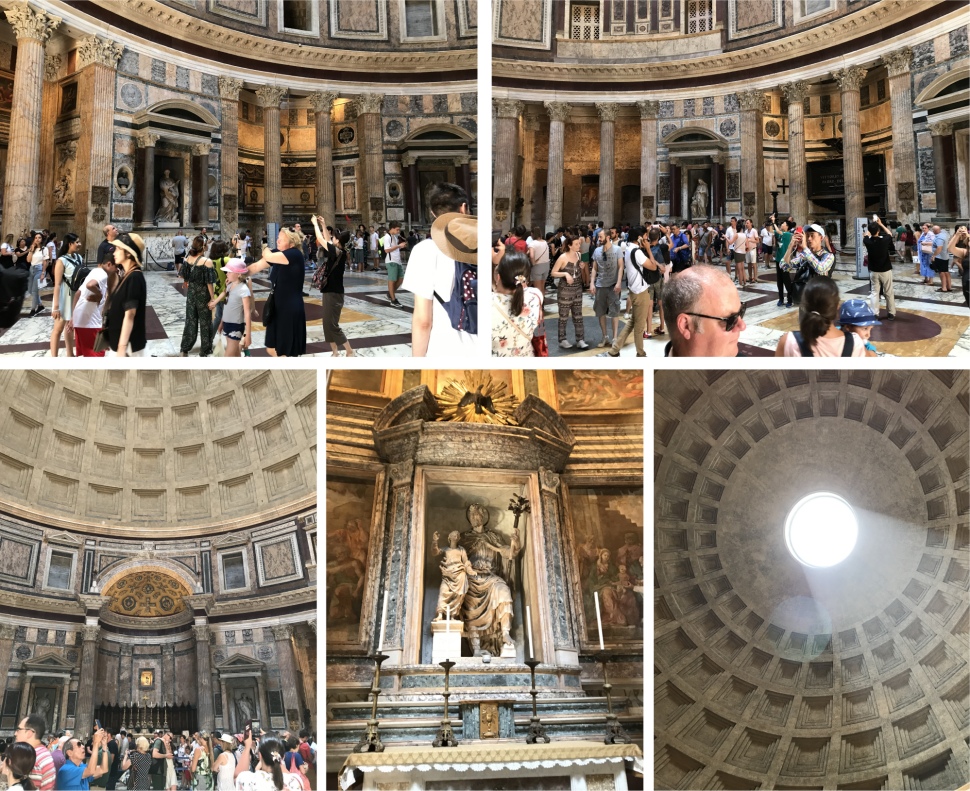 Pantheon Interior |
On entering the door, we were temporarily blinded by a shaft of bright sunlight pouring through the oculus, then once inside out of the direct glare, the spectacle was overwhelming. I suddenly felt insignificant in this huge empty space with a sprawl of humanity at its base. I guess this is how you were supposed to feel in front of the Gods.




